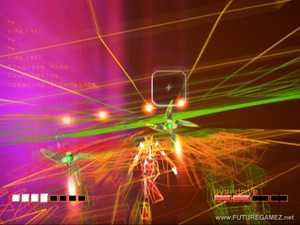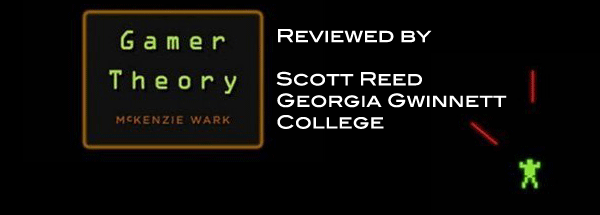
Agony (The Cave)
 Gamer Theory's introduction, “Agony (on The Cave)” offers not a take on any particular game, but rather the first phase in Wark's configuration of gamespace: a much broader and more holistic understanding of the way that gaming and ubiquitous digital environments precede the gamer. Unlike Plato's Cave, which supposes a more real and legitimate world outside our basic understanding, Wark's notion of gamespace presupposes no “outside” of true forms. Instead, “the game,” Wark argues, “has colonized its rivals in the cultural realm,” both fueling and fueled by an equally ubiquitous (and distinctly American, he argues later) ideology that “imagines the world as a level playing field, upon which all folks are equal” (8). Echoing Guy Debord, as he does repeatedly throughout the book, “life appears as a vast accumulation of commodities and spectacles, of things wrapped in images and images sold as things,” but in a digital gamespace, even life outside the game takes on those same features (6). The digital, in that sense, precedes us and overwrites any more organic understanding of the world. In this sense, this opening chapter initiates a tension sustained throughout Gamer Theory: between ideology and the possibility of meaningful resistance. The digital isn't something to be refused, Wark argues, but rather to be engaged affirmatively: “The gamer arrives at the beginning of a reflective life, a gamer theory, by stepping out of The Cave – and returning to it” (19). In the chapters that follow, Wark turns to individual games as case studies for engaging gamespace in its own terms – that is, through the games themselves. Collapsing the distinction between gamer and critic, Wark issues the central challenge of his book:
Gamer Theory's introduction, “Agony (on The Cave)” offers not a take on any particular game, but rather the first phase in Wark's configuration of gamespace: a much broader and more holistic understanding of the way that gaming and ubiquitous digital environments precede the gamer. Unlike Plato's Cave, which supposes a more real and legitimate world outside our basic understanding, Wark's notion of gamespace presupposes no “outside” of true forms. Instead, “the game,” Wark argues, “has colonized its rivals in the cultural realm,” both fueling and fueled by an equally ubiquitous (and distinctly American, he argues later) ideology that “imagines the world as a level playing field, upon which all folks are equal” (8). Echoing Guy Debord, as he does repeatedly throughout the book, “life appears as a vast accumulation of commodities and spectacles, of things wrapped in images and images sold as things,” but in a digital gamespace, even life outside the game takes on those same features (6). The digital, in that sense, precedes us and overwrites any more organic understanding of the world. In this sense, this opening chapter initiates a tension sustained throughout Gamer Theory: between ideology and the possibility of meaningful resistance. The digital isn't something to be refused, Wark argues, but rather to be engaged affirmatively: “The gamer arrives at the beginning of a reflective life, a gamer theory, by stepping out of The Cave – and returning to it” (19). In the chapters that follow, Wark turns to individual games as case studies for engaging gamespace in its own terms – that is, through the games themselves. Collapsing the distinction between gamer and critic, Wark issues the central challenge of his book:
"Play within the game, but against gamespace. Be ludic, but also lucid." (19)
Allegory (on The Sims)
To engage productively with games, Wark makes his first foray into the ways that games can produce meaning. To engage productively in gamespace is to engage games at the level of their algorithmic meanings, and to locate there the possibility of a parallel “allegorithm.” (Wark does presuppose some familiarity with foundational works in gaming theory – particularly those of Johan Huizinga and Roger Caillois, whom I'll address elsewhere in the interest of clarity.)
 A conceptual braid of rules and meanings, “allegorithm” approaches the issue of what games “mean” in the most slippery and poststructural sense, built on Walter Benjamin's notion of allegory. In the allegorical mode, Wark writes, “anything can be made to mean anything else” (29). This free-for-all is in one sense a symptom of the fragmentation of the modern world, but it's also a means of “shattering the illusion of bourgeois [stable, semiotic] order, revealing the means by which it is made” (29). In this case, the “means” in question are those of rules – the mathematical principles which structure meaning in gamespace. In the case of The Sims, Wark quickly reasons that the game's rules lead only towards acquiring more household items for your virtual "people," and leading them down the safe paths of middle-class career advancement. The rules, while allowing for plenty, promote little else. However, Wark takes The Sims's emphasis on appearance and consumption not just at face value, but also as allegorically representing "the expulsion of quality from the world," leaving only appearances (38).
A conceptual braid of rules and meanings, “allegorithm” approaches the issue of what games “mean” in the most slippery and poststructural sense, built on Walter Benjamin's notion of allegory. In the allegorical mode, Wark writes, “anything can be made to mean anything else” (29). This free-for-all is in one sense a symptom of the fragmentation of the modern world, but it's also a means of “shattering the illusion of bourgeois [stable, semiotic] order, revealing the means by which it is made” (29). In this case, the “means” in question are those of rules – the mathematical principles which structure meaning in gamespace. In the case of The Sims, Wark quickly reasons that the game's rules lead only towards acquiring more household items for your virtual "people," and leading them down the safe paths of middle-class career advancement. The rules, while allowing for plenty, promote little else. However, Wark takes The Sims's emphasis on appearance and consumption not just at face value, but also as allegorically representing "the expulsion of quality from the world," leaving only appearances (38).
To understand the “allegorithmic” braids between rules and meaning is the beginning of what Wark, possibly borrowing from Jerome McGann's Radiant Textuality, calls an “n-dimensional” insight: “it intuits behind appearances interactions of many variables.” The Sims, then, provides Wark with an ideal first test case, as the game relies on a notably open-ended play style “where play is free from work [utility], from necessity, from seriousness, from morality” (42). Then, in a jarring turn, Wark pivots the chapter towards a brief discussion of the geopolitics of coltan mining, which, though abrupt, allows Wark to perform the “allegorithmic” meaning he encounters in The Sims. He shatters the game's insistence on a “bourgeois order” by troping its “free” play against the very real human costs of our technology.
In that regard, the “allegorithmic” structure of Gamer Theory is less designed as a free-play of meaning than as an attempt to use games to puncture the perceptual lenses of gamespace: to point to the world outside The Cave in order to engage it more productively.
America (on Civilization III)
Gamer Theory's third chapter turns into a sort of capsule history of the emergence of gamespace, built at least in part on America's westward expansion, and approached through an allegorithmic reading of the strategy game Civilization III. Of particular interest in this chapter is the introduction of a set of terms that Wark returns to repeatedly throughout the book: topic, topography, and topology. Echoing the “discourse network” theory of Friedrich Kittler, Wark posits how the narrative of westward expansion is both ideological and technological: the space of America is not just mastered, but rewritten, because of the “lines” of influence produced by the telegraph and railroad. And yet, in the “topology” of gamespace, that gradual evolution is only intelligible as “a continuous field of equivalent and exchangeable values, instantly communicable anywhere” (56).
In that sense, Civilization III, as an open ended game appearing to afford the player nearly limitless options for how to evolve their culture, “recapitulates not only world history but media history, the history of media as form,” and that history of media as form is always-already a distinctly American one: “Whoever wins is America, in that the logic of the game itself is America. America unbound” (74).
Analog (on Katamari Damacy)
The victory of “America” is less as a matter of geopolitics (in Francis Fukuyama's “end of history” sense) than as Wark's way of phrasing the ascendance of the digital itself. Reading the quirky Japanese game Katamari Damacy alongside the myth of Sisyphus, Wark re-sketches the complex evolution of topic, topography, and topology using the distinction between the analog and the digital. “The analog is a variation along a line, a difference of more – and less. The digital is divided by a line, a distinction between either/or” (84).
 The great achievements of Odysseus are a relic of topical times, of the prevailing logic of more and less: more greatness, more power, more patience, etc. The myth of Sisyphus represents the topographical balancing of the two: Sisyphus's great labor occurring within the context of a space dominated by the either/or of the law (77). Katamari, on the other hand, shows the ascendance of the digital. Read allegorically, Katamari's main process – rolling discrete objects up into massive balls – is “to make the universe over... as an effect of the digital as a command” (92). The strong claim here is not merely that games make meaning through discrete digital means, but that gaming allows us to experience how all meaning has been rendered as discrete and digital.
The great achievements of Odysseus are a relic of topical times, of the prevailing logic of more and less: more greatness, more power, more patience, etc. The myth of Sisyphus represents the topographical balancing of the two: Sisyphus's great labor occurring within the context of a space dominated by the either/or of the law (77). Katamari, on the other hand, shows the ascendance of the digital. Read allegorically, Katamari's main process – rolling discrete objects up into massive balls – is “to make the universe over... as an effect of the digital as a command” (92). The strong claim here is not merely that games make meaning through discrete digital means, but that gaming allows us to experience how all meaning has been rendered as discrete and digital.
Atopia (on Vice City)
Wark's fifth chapter takes up the problem of all-encompassing digitality by considering a question near and dear to most compositionists: how the either/or logic of the digital evacuates the possibility for nuanced thinking. This question is bounced not only off of a reading of the controversial Grand Theft Auto: Vice City, but also by a further extension of Gamer Theory's concern over space.
While often used as the poster child for the destructive nihilism of modern gaming, Wark sees the open-world ultra-violence of Vice City as “charming.” “It is a game about transgression in which it is not possible to break the rules,” because its chaos is still inscribed by the game's parameters – any move to “break the rules” just lands the player in a different game (118). (Stealing a car is part of the game's rules; doing so initiates the rule-bound process of being chased by cops, etc.) It's not the game's content that should concern people, but rather “the form of the game itself, and its compromises with the world beyond” that can form the basis for a meaningful conversation about games (123).
That scene of exchange prompts Wark to think of gamespace as not a dystopia, but rather as an “atopia.” While utopia is non-violent because it dissolves the normal grammar of relations (everything is one topic), atopia seems like nothing but violence because all experience is understood as so many discrete (digital) units bounding off one another (119). The opportunity for better, more nuanced thinking derives not from “objective, rational, abstract” inquiry but from a gamer theory that is “subjective, intuitive, particular” about forming connections between games and the “real world” (124).
Battle (on Rez)
The topic of “battle” allows Wark to engage openly with two themes running latently throughout much of Gamer Theory: competition and boredom. A chief effect of gamespace is its tendency to render all experience as a game, one with winners and losers where clear and definitive results are always received. “Battle” is not only the process of resolving games – determining winners and losers in this binary logic – but also about staving off the spectre of a deep existential boredom: the lapse of meaningfulness that occurs in the absence of any particular game.
 The act of targeting so central to battle is a double-edged sword – it both “stabilizes” the gamer's relationship with the Other pictured onscreen while perpetuating that relationship within the boundaries of the game (131). (Destroying the target doesn't end the game so much as perpetuate it in other forms.) While games often try to relieve some of the existential tension of battle through their narrative elements, Wark dismisses the “good vs. evil” narrative sheen over most games as bad faith attempts to introduce a simplified moral calculus into amoral and topological gamespace (141-2). The problem with such narratives isn't simply their ideological reinscription of violence, but rather the fact that they misdirect critics from the kinds of “oscillating” identities put into play by games themselves (150).
The act of targeting so central to battle is a double-edged sword – it both “stabilizes” the gamer's relationship with the Other pictured onscreen while perpetuating that relationship within the boundaries of the game (131). (Destroying the target doesn't end the game so much as perpetuate it in other forms.) While games often try to relieve some of the existential tension of battle through their narrative elements, Wark dismisses the “good vs. evil” narrative sheen over most games as bad faith attempts to introduce a simplified moral calculus into amoral and topological gamespace (141-2). The problem with such narratives isn't simply their ideological reinscription of violence, but rather the fact that they misdirect critics from the kinds of “oscillating” identities put into play by games themselves (150).
Boredom (on State of Emergency)
If Battle is the violent, albeit engaging and exciting, process by which games produce a sense of self, Boredom represents the alternative. If the continual agon of Battle is about the persistence of virtual conflict, Boredom is the real gap caused by its absence: what Bataille called “the ambivalent gift” of our cultural surplus (155). That surplus is the scene for a number of tangential-yet-related problems for Wark to engage: the difference between work and play and the subjectivity of the gamer being a few.
Yet, the existential morass of boredom – an involuntary loss of meaningfulness – is both a sign of the limitations of gamespace (and, I might note, a potentially significant term for better understanding the lived experience of gaming subjects) and the possibility for more radical solutions. It's through boredom, Wark argues, that gamers (and Gamer Theory) might try to grasp at something “out of bounds,” something unaccounted for by the binary logics of gamespace. Boredom may be what's left when gamespace has finished annihilating playfulness (172), but every game provides a moment, a “topic,” where existential self-discovery does become possible.
Earlier in the chapter, Wark notes: “In a game, you can choose which circumstances are to be the necessity against which you will grind down the shape of a self. Even if, in so choosing, you click to opt out of making history” (165). The closing gesture of the chapter though, reinstantiates the possibility of that “history making,” but only through engagement with gaming and gamespace itself.
Complex (on Deus Ex)
Once “play [has disappeared] into the game,” what do we do (174)?
Wark's penultimate chapter takes up that question by positioning the game Deus Ex as an interface metaphor for mapping out the interior of the “military information complex” from within The Cave. More colloquially, one might say that “Complex” begins the closing movement of Gamer Theory – a gesture that offers an affirmative sense of how subjectivity, play, and discourse can be rethought in our moment by the act of “doing theory” through (not just about) games.
In this specific instance, Wark constructs a “Greimas square” out of the variable narrative endings of the action-adventure game Deus Ex, locating in each narrative possibility a different configuration of “the rules of the meaning making game” (183). Confronting two of the dominant narratives of technological mediation – those of merger with technology and separation from it – Wark hazards a “schizoid” analysis of his own: “undoing the agon between one positivity and another opens up more positive differences,” that is, more possible subject positions (196).
To put it differently, “Complex” offers in a dense and multilayered fashion a way of sketching out what a gamer subjectivity might look like, at least partially by disrupting the one-two binary of “player” and “worker” (the terms which Wark tropes against, respectively, "separation from" and "merger with" technology). In so doing, Gamer Theory opens up a space of “possible perceptions and actions,” neither determined by the “game” nor completely separate from it.
Conclusions (on SimEarth)
Wark gestures in his concluding chapter to some of the “possible perceptions” afforded by the “complex” of forces that characterize the scene of Gamer Theory. Motivating his closing remarks is a renewed focus on the global environment of gaming, and the difficulties inherent in thinking within gamespace. His solution is to rethink the shape of that space itself:
“Gamespace is just like your Playstation. It appears to itself [and by extension to gamers] as a rigorous game, with every action accounted for, and yet it relies on a huge power cord poking out the back that sucks in energy from an elsewhere for which it makes no allowance” (210).
Ultimately, the game(space) isn't as fully walled-off from the world as its own fictions might suggest.
One way of further exploring that sense of gamespace as some non-critical and hermetically sealed state of being, Wark explores the game SimEarth as an example of an agon in which the choices “appear as choices between positive terms” (215). The SimEarth gamer might have to choose between building their world around agriculture or science, but Wark interjects possibilities based on what Victor Vitanza might call a nonpositive affirmation, looking for terms outside the agon to keep the critical process moving despite the strictures of the game: "How are we to think of non-science, of non-agriculture?” – that is, of all the other possibilities temporarily walled off by the gamespace?
The virtue of a game like SimEarth, by catching so many terms within the variables it uses to simulate the planet's lifecycle, is that it shows how gamespace “can know its limit, its end, but not what to do about it" (220). In that moment of confusion and instability – when classical terms like history and subjectivity seem so up-for-grabs – Wark concludes by returning to the topic of The Cave, reminding the reader that the only hope for working beyond gamespace is “by going further and further into gamespace [to] come out on the other side of it” (224).







